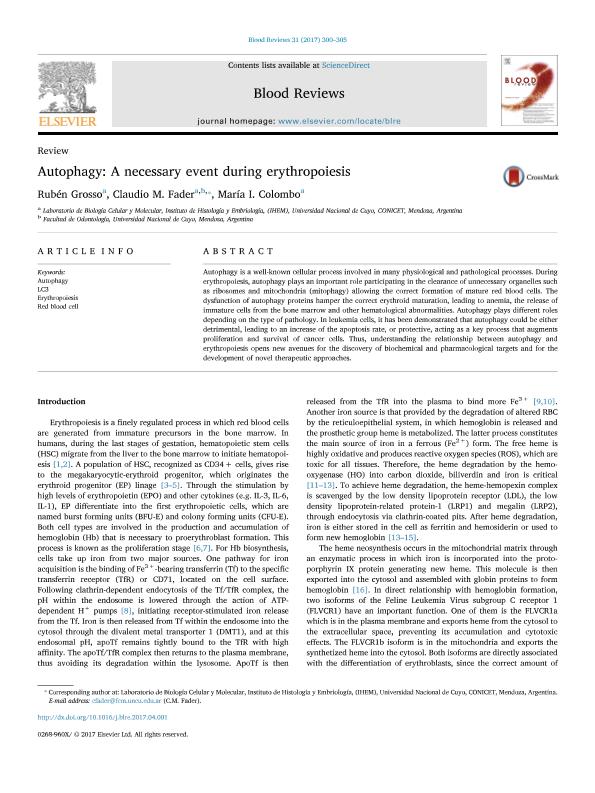Mostrar el registro sencillo del ítem
dc.contributor.author
Grosso, Rubén Adrián

dc.contributor.author
Fader Kaiser, Claudio Marcelo

dc.contributor.author
Colombo, Maria Isabel

dc.date.available
2018-11-05T13:41:45Z
dc.date.issued
2017-09
dc.identifier.citation
Grosso, Rubén Adrián; Fader Kaiser, Claudio Marcelo; Colombo, Maria Isabel; Autophagy: A necessary event during erythropoiesis; Churchill Livingstone; Blood Reviews; 31; 5; 9-2017; 300-305
dc.identifier.issn
0268-960X
dc.identifier.uri
http://hdl.handle.net/11336/63591
dc.description.abstract
Autophagy is a well-known cellular process involved in many physiological and pathological processes. During erythropoiesis, autophagy plays an important role participating in the clearance of unnecessary organelles such as ribosomes and mitochondria (mitophagy) allowing the correct formation of mature red blood cells. The dysfunction of autophagy proteins hamper the correct erythroid maturation, leading to anemia, the release of immature cells from the bone marrow and other hematological abnormalities. Autophagy plays different roles depending on the type of pathology. In leukemia cells, it has been demonstrated that autophagy could be either detrimental, leading to an increase of the apoptosis rate, or protective, acting as a key process that augments proliferation and survival of cancer cells. Thus, understanding the relationship between autophagy and erythropoiesis opens new avenues for the discovery of biochemical and pharmacological targets and for the development of novel therapeutic approaches.
dc.format
application/pdf
dc.language.iso
eng
dc.publisher
Churchill Livingstone

dc.rights
info:eu-repo/semantics/openAccess
dc.rights.uri
https://creativecommons.org/licenses/by-nc-sa/2.5/ar/
dc.subject
Autophagy
dc.subject
Erythropoiesis
dc.subject
Lc3
dc.subject
Red Blood Cell
dc.subject.classification
Otras Ciencias Biológicas

dc.subject.classification
Ciencias Biológicas

dc.subject.classification
CIENCIAS NATURALES Y EXACTAS

dc.title
Autophagy: A necessary event during erythropoiesis
dc.type
info:eu-repo/semantics/article
dc.type
info:ar-repo/semantics/artículo
dc.type
info:eu-repo/semantics/publishedVersion
dc.date.updated
2018-10-23T15:53:07Z
dc.identifier.eissn
1532-1681
dc.journal.volume
31
dc.journal.number
5
dc.journal.pagination
300-305
dc.journal.pais
Estados Unidos

dc.journal.ciudad
Nueva York
dc.description.fil
Fil: Grosso, Rubén Adrián. Consejo Nacional de Investigaciones Científicas y Técnicas. Centro Científico Tecnológico Conicet - Mendoza. Instituto de Histología y Embriología de Mendoza Dr. Mario H. Burgos. Universidad Nacional de Cuyo. Facultad de Ciencias Médicas. Instituto de Histología y Embriología de Mendoza Dr. Mario H. Burgos; Argentina
dc.description.fil
Fil: Fader Kaiser, Claudio Marcelo. Consejo Nacional de Investigaciones Científicas y Técnicas. Centro Científico Tecnológico Conicet - Mendoza. Instituto de Histología y Embriología de Mendoza Dr. Mario H. Burgos. Universidad Nacional de Cuyo. Facultad de Ciencias Médicas. Instituto de Histología y Embriología de Mendoza Dr. Mario H. Burgos; Argentina. Universidad Nacional de Cuyo. Facultad de Odontologia; Argentina
dc.description.fil
Fil: Colombo, Maria Isabel. Consejo Nacional de Investigaciones Científicas y Técnicas. Centro Científico Tecnológico Conicet - Mendoza. Instituto de Histología y Embriología de Mendoza Dr. Mario H. Burgos. Universidad Nacional de Cuyo. Facultad de Ciencias Médicas. Instituto de Histología y Embriología de Mendoza Dr. Mario H. Burgos; Argentina
dc.journal.title
Blood Reviews

dc.relation.alternativeid
info:eu-repo/semantics/altIdentifier/doi/https://doi.org/10.1016/j.blre.2017.04.001
dc.relation.alternativeid
info:eu-repo/semantics/altIdentifier/url/https://www.sciencedirect.com/science/article/pii/S0268960X17300206
Archivos asociados
